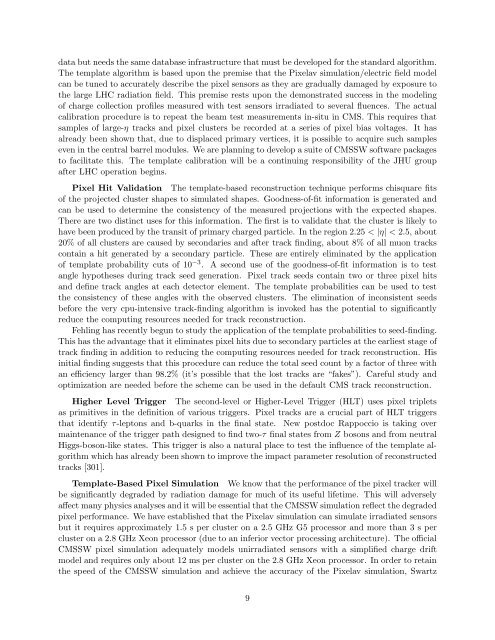proposal2007_draft09.. - Henry A. Rowland Department of Physics ...
proposal2007_draft09.. - Henry A. Rowland Department of Physics ...
proposal2007_draft09.. - Henry A. Rowland Department of Physics ...
You also want an ePaper? Increase the reach of your titles
YUMPU automatically turns print PDFs into web optimized ePapers that Google loves.
data but needs the same database infrastructure that must be developed for the standard algorithm.<br />
The template algorithm is based upon the premise that the Pixelav simulation/electric field model<br />
can be tuned to accurately describe the pixel sensors as they are gradually damaged by exposure to<br />
the large LHC radiation field. This premise rests upon the demonstrated success in the modeling<br />
<strong>of</strong> charge collection pr<strong>of</strong>iles measured with test sensors irradiated to several fluences. The actual<br />
calibration procedure is to repeat the beam test measurements in-situ in CMS. This requires that<br />
samples <strong>of</strong> large-η tracks and pixel clusters be recorded at a series <strong>of</strong> pixel bias voltages. It has<br />
already been shown that, due to displaced primary vertices, it is possible to acquire such samples<br />
even in the central barrel modules. We are planning to develop a suite <strong>of</strong> CMSSW s<strong>of</strong>tware packages<br />
to facilitate this. The template calibration will be a continuing responsibility <strong>of</strong> the JHU group<br />
after LHC operation begins.<br />
Pixel Hit Validation The template-based reconstruction technique performs chisquare fits<br />
<strong>of</strong> the projected cluster shapes to simulated shapes. Goodness-<strong>of</strong>-fit information is generated and<br />
can be used to determine the consistency <strong>of</strong> the measured projections with the expected shapes.<br />
There are two distinct uses for this information. The first is to validate that the cluster is likely to<br />
have been produced by the transit <strong>of</strong> primary charged particle. In the region 2.25 < |η| < 2.5, about<br />
20% <strong>of</strong> all clusters are caused by secondaries and after track finding, about 8% <strong>of</strong> all muon tracks<br />
contain a hit generated by a secondary particle. These are entirely eliminated by the application<br />
<strong>of</strong> template probability cuts <strong>of</strong> 10 −3 . A second use <strong>of</strong> the goodness-<strong>of</strong>-fit information is to test<br />
angle hypotheses during track seed generation. Pixel track seeds contain two or three pixel hits<br />
and define track angles at each detector element. The template probabilities can be used to test<br />
the consistency <strong>of</strong> these angles with the observed clusters. The elimination <strong>of</strong> inconsistent seeds<br />
before the very cpu-intensive track-finding algorithm is invoked has the potential to significantly<br />
reduce the computing resources needed for track reconstruction.<br />
Fehling has recently begun to study the application <strong>of</strong> the template probabilities to seed-finding.<br />
This has the advantage that it eliminates pixel hits due to secondary particles at the earliest stage <strong>of</strong><br />
track finding in addition to reducing the computing resources needed for track reconstruction. His<br />
initial finding suggests that this procedure can reduce the total seed count by a factor <strong>of</strong> three with<br />
an efficiency larger than 98.2% (it’s possible that the lost tracks are “fakes”). Careful study and<br />
optimization are needed before the scheme can be used in the default CMS track reconstruction.<br />
Higher Level Trigger The second-level or Higher-Level Trigger (HLT) uses pixel triplets<br />
as primitives in the definition <strong>of</strong> various triggers. Pixel tracks are a crucial part <strong>of</strong> HLT triggers<br />
that identify τ-leptons and b-quarks in the final state. New postdoc Rappoccio is taking over<br />
maintenance <strong>of</strong> the trigger path designed to find two-τ final states from Z bosons and from neutral<br />
Higgs-boson-like states. This trigger is also a natural place to test the influence <strong>of</strong> the template algorithm<br />
which has already been shown to improve the impact parameter resolution <strong>of</strong> reconstructed<br />
tracks [301].<br />
Template-Based Pixel Simulation We know that the performance <strong>of</strong> the pixel tracker will<br />
be significantly degraded by radiation damage for much <strong>of</strong> its useful lifetime. This will adversely<br />
affect many physics analyses and it will be essential that the CMSSW simulation reflect the degraded<br />
pixel performance. We have established that the Pixelav simulation can simulate irradiated sensors<br />
but it requires approximately 1.5 s per cluster on a 2.5 GHz G5 processor and more than 3 s per<br />
cluster on a 2.8 GHz Xeon processor (due to an inferior vector processing architecture). The <strong>of</strong>ficial<br />
CMSSW pixel simulation adequately models unirradiated sensors with a simplified charge drift<br />
model and requires only about 12 ms per cluster on the 2.8 GHz Xeon processor. In order to retain<br />
the speed <strong>of</strong> the CMSSW simulation and achieve the accuracy <strong>of</strong> the Pixelav simulation, Swartz<br />
9
















